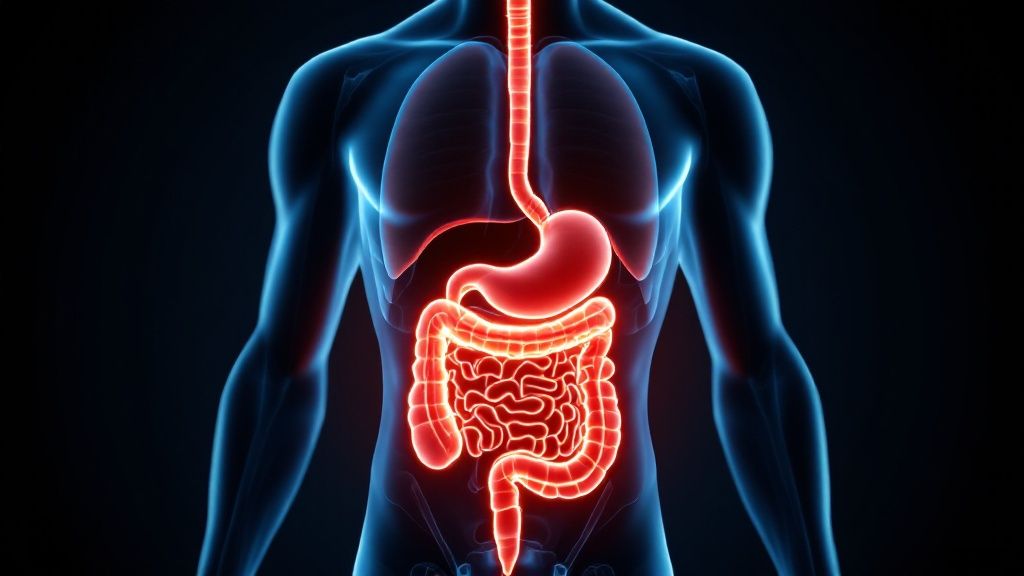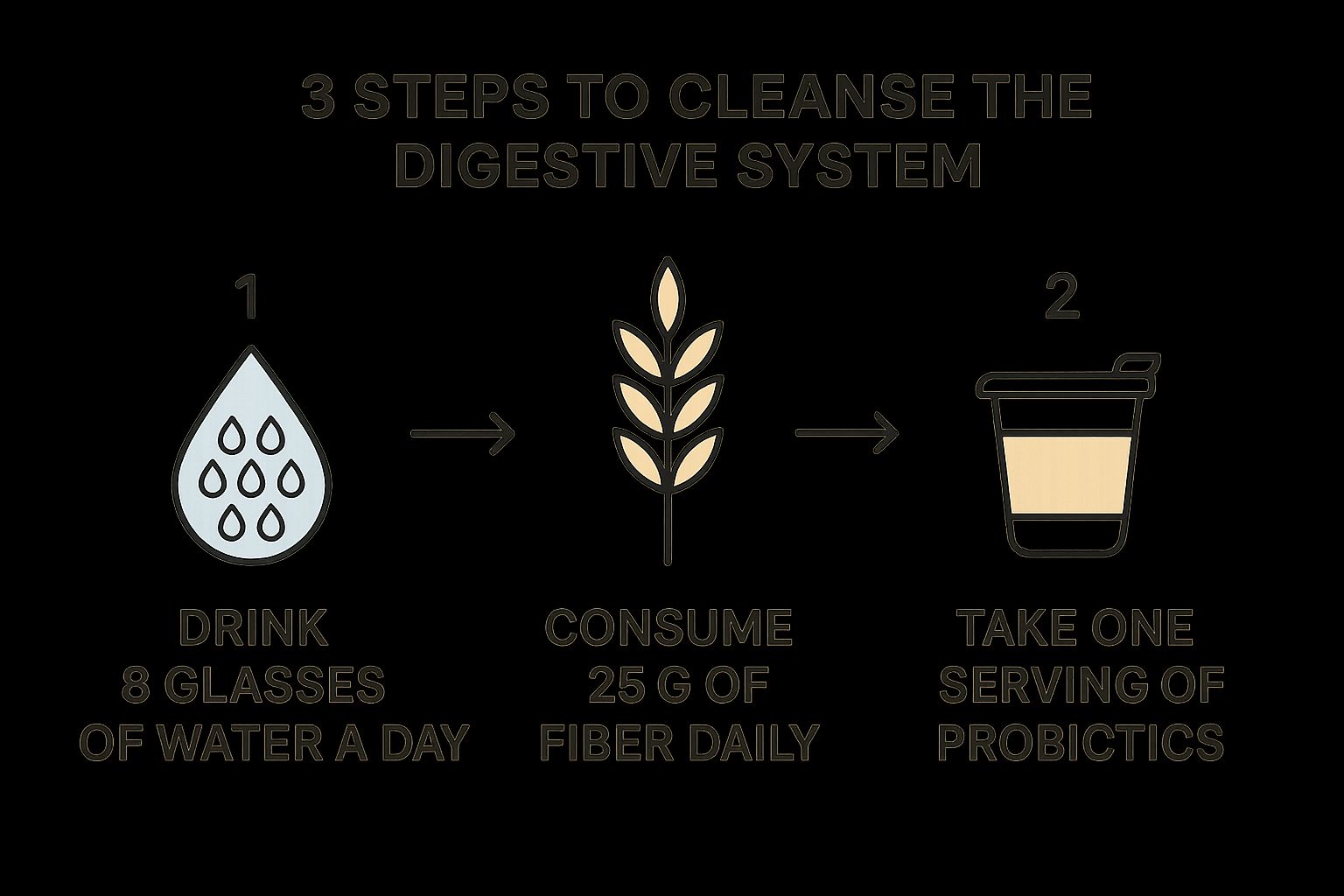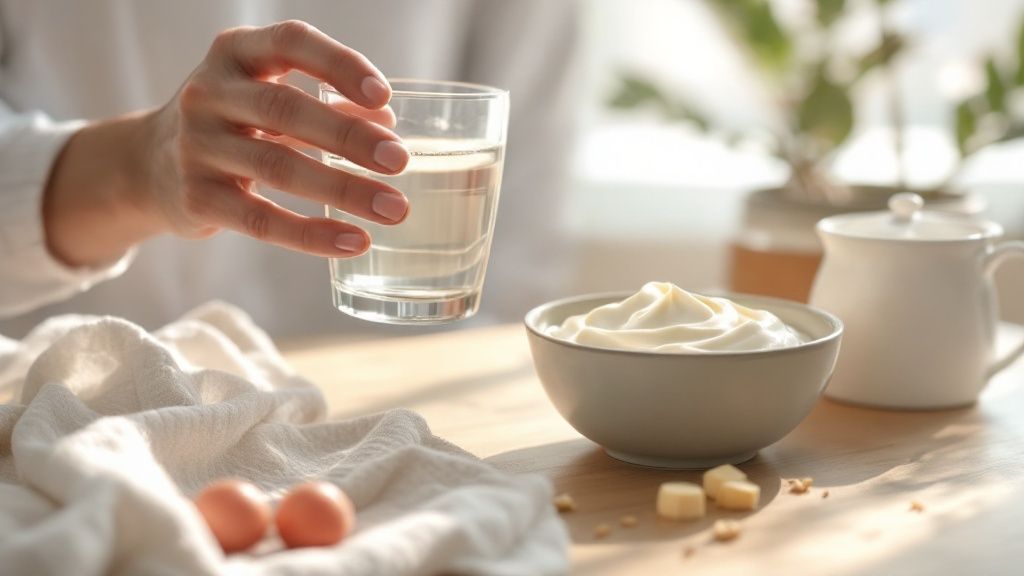Your body has a way of telling you when things are off, and often, the first whispers come from your digestive system. Learning how to cleanse your digestive system really begins with tuning into these signals. We often dismiss things like occasional bloating, nagging fatigue, brain fog, or random skin issues as just "part of …
Your body has a way of telling you when things are off, and often, the first whispers come from your digestive system. Learning how to cleanse your digestive system really begins with tuning into these signals. We often dismiss things like occasional bloating, nagging fatigue, brain fog, or random skin issues as just "part of life," but they're often subtle hints that your body’s natural detox processes are overwhelmed.
A cleanse isn't about punishment or deprivation; it’s a gentle, supportive way to restore balance.
Signs Your Digestive System Needs a Reset

It’s so easy to normalize feeling "a little off." We blame a busy schedule or stress. But more often than not, these persistent discomforts are your gut's way of telling you it's struggling under the load of modern life—processed foods, environmental toxins, and constant stress.
A burdened digestive system doesn't just cause stomach aches. Its effects can ripple throughout your entire body.
You might notice you're dragging yourself through the day, even after getting a solid eight hours of sleep. Or maybe you're dealing with a persistent mental haze that makes it hard to concentrate at work. These problems can often be traced back to poor nutrient absorption and low-grade inflammation that starts in the gut.
Beyond the Obvious Symptoms
When we think of digestive trouble, bloating and constipation are usually the first things that come to mind. While those are certainly clear indicators, the signs of an overburdened system can be much more subtle and surprising.
Keep an eye out for less obvious signals like these:
- Persistent Skin Issues: Conditions like acne, eczema, or mysterious rashes are frequently linked to an imbalance in the gut microbiome. What happens in the gut often shows up on your skin.
- New Food Sensitivities: Are you suddenly reacting to foods you've eaten your whole life without issue? This can be a sign that your intestinal lining is compromised, a condition often called "leaky gut."
- Unexplained Mood Swings: The gut-brain axis is a real and powerful connection. When your digestion is out of whack, it can directly affect your mood, anxiety levels, and mental clarity.
- Weakened Immunity: Do you feel like you're catching every cold that goes around? Since a huge portion of your immune system—some experts say up to 70%—is located in your gut, frequent illnesses can mean it needs support.
Recognizing these patterns is your first and most important step. If this sounds familiar, you might want to explore our detailed guide on the signs you need to detox.
It's not just you. People are increasingly aware of the gut's central role in overall health. In fact, the global market for digestive health products is expected to hit an incredible USD 116.2 billion by 2032, a clear sign that consumers are actively seeking solutions to support better gut function.
Thinking about a cleanse as a supportive act, rather than a restrictive one, completely changes the perspective. It’s a chance to clear out the junk, deeply nourish your body, and let your digestive system do the job it was designed for. The result? More energy, clearer thinking, and a profound sense of well-being.
Building Your Gut-Friendly Cleansing Plate
Let’s be honest: the idea of a “cleanse” often brings to mind deprivation and complicated rules. But when it comes to resetting your digestive system, the most powerful tool you have is your fork. It’s not about what you eliminate; it’s about what you add to your plate.
Think of every meal as a chance to give your gut exactly what it needs to heal and work its best. Shifting your mindset from restriction to nourishment is the secret sauce to making this whole process feel good and stick for the long haul.
The Power Duo: Fiber and Water
Fiber is the unsung hero of gut health. Seriously. It acts like a gentle scrub brush for your digestive tract, helping sweep out waste and keeping things moving along smoothly. A great target for most adults is 25-30 grams of fiber per day.
So, how do you get there? It’s easier than you think.
- Load up on leafy greens: Spinach, kale, and arugula are fantastic sources.
- Embrace berries: Raspberries and blackberries are fiber superstars and are naturally low in sugar.
- Add in legumes: Lentils, chickpeas, and black beans are a one-two punch of fiber and plant-based protein.
- Don't forget cruciferous veggies: Broccoli and Brussels sprouts contain special compounds that give your liver a helping hand in detoxification.
And you absolutely can't forget hydration. All that wonderful fiber needs water to do its job effectively.

As you can see, getting these fundamentals right—plenty of water, fiber, and good bacteria—creates a positive feedback loop that helps your gut thrive.
Your Digestive Cleanse Food Guide
To make this even simpler, here's a quick-reference guide. The goal is to load up on the good stuff, which naturally reduces your desire for the things that weigh your system down.
| Food Category | Foods to Emphasize | Foods to Temporarily Avoid |
|---|---|---|
| Vegetables | Leafy greens, broccoli, Brussels sprouts, asparagus, artichokes | Starchy vegetables like corn and potatoes in large amounts |
| Fruits | Berries, apples, pears, avocado | High-sugar fruits like mango and banana (in moderation is fine) |
| Proteins | Wild-caught fish, organic chicken, lentils, chickpeas, organic tofu | Processed meats, red meat, fried foods |
| Grains | Quinoa, brown rice, oats (in moderation) | Refined grains, white bread, pasta, pastries |
| Fats | Olive oil, nuts, seeds | Industrial seed oils (canola, soy, corn), trans fats |
| Drinks | Filtered water, herbal teas, green juice | Soda, alcohol, sugary juices, excessive caffeine |
Think of this as your roadmap for a few weeks. It’s not about perfection, but about making conscious choices to support your body’s cleansing process.
Call in the Good Guys: Probiotic-Rich Foods
Your gut is home to trillions of bacteria, and you want to make sure the good guys are winning. Probiotics are these beneficial bacteria, and they are crucial for breaking down food, producing vitamins, and keeping the bad microbes in check.
Fermented foods are your best source. Try to get a daily serving of one of these:
- Sauerkraut or Kimchi: Look for raw, unpasteurized versions in the refrigerated section of your grocery store. That’s where the live cultures are!
- Plain Yogurt or Kefir: Go for unsweetened options that list "live and active cultures" on the label.
- Miso: This fermented soybean paste is perfect for adding a savory, umami flavor to soups and salad dressings.
Building a cleansing plate is about addition, not subtraction. By adding more fiber-rich vegetables, probiotic foods, and clean proteins, you naturally crowd out the processed foods that burden your digestive system. It’s a gentler, more effective approach.
Keeping Your Meals Simple and Delicious
You don't have to be a master chef to eat this way. Simplicity is your friend.
Start your day with a smoothie—a handful of spinach, some berries, a scoop of clean protein powder, and unsweetened almond milk blend up into a perfect, easy-to-digest breakfast.
For lunch, think big. A huge salad loaded with colorful veggies, grilled chicken or a can of chickpeas, and a simple olive oil and lemon juice vinaigrette is filling and nutrient-dense.
Dinner can be as easy as a baked piece of salmon with a side of steamed broccoli and quinoa. The focus is always on whole, unprocessed foods.
For more inspiration, you can explore other digestive health natural remedies that can beautifully complement these dietary changes. This approach ensures you feel satisfied and full of energy—not deprived—making it so much easier to create new habits that last.
Lifestyle Habits That Support Your Cleanse

To really get the most out of a digestive cleanse, you have to look beyond what’s on your plate. Think of it this way: your diet is just one piece of the puzzle. How you handle stress, how much you sleep, and how you move your body are just as critical to your gut health.
Ignoring these things is like trying to build a house with only three walls. It just won't stand up. A successful cleanse is a holistic one, where your daily habits work with your diet, not against it.
Manage Stress to Settle Your Stomach
The link between your brain and your gut is a powerful one. When you're constantly stressed, your brain sends out alarm signals that can throw your entire digestive system into chaos, leading to inflammation and even messing with your gut bacteria. Calming your mind isn't just a nice idea—it's essential.
You don't need to book a week-long silent retreat to see a difference. Simple, everyday techniques can work wonders.
- Mindful Breathing: Feeling overwhelmed? Try "box breathing." Just take five minutes to inhale for a count of four, hold for four, exhale for four, and hold for four. This simple exercise can pull your nervous system out of that constant "fight or flight" mode.
- Journaling: Take a few minutes before bed to just dump your thoughts onto paper. It’s a great way to process the day and quiet down the mental chatter that can keep you up at night.
- Digital Detox: Try putting your phone and screens away for at least 30 minutes before bed. Giving your brain a break from that constant stream of information is a game-changer for reducing chronic stress.
A calm mind leads to a calm gut. When you actively work to lower your stress levels, you’re creating the peaceful environment your digestive system needs to heal and reset. This part is non-negotiable.
Prioritize Rest for Cellular Repair
Sleep is prime time for your body's repair crew. While you're resting, your system is busy fixing tissues, filing away memories, and, most importantly for us, healing the lining of your digestive tract. When you skimp on sleep, you're interrupting this vital work.
Not getting enough sleep consistently has been directly linked to more inflammation in the gut and a less healthy microbiome. Making sure you get 7-9 hours of quality sleep is one of the best things you can do to support your cleanse. A simple, relaxing bedtime routine can signal to your body that it's time to power down.
Gentle Movement to Stimulate Digestion
During a cleanse, pushing yourself with intense workouts can actually add more stress to your body. Gentle movement, on the other hand, is your best friend. It gets blood flowing to your digestive organs and encourages peristalsis—the natural muscle contractions that keep things moving through your intestines.
A daily 20-30 minute walk, a gentle yoga session, or some light stretching is perfect. The goal is to feel energized and refreshed, not exhausted. Listen to what your body is telling you.
By weaving these simple habits into your daily routine, you're supporting your cleanse from all angles and setting yourself up for a much more effective and lasting result.
Taking Your Cleanse to the Next Level with Professional Therapies
Making smart changes to what you eat and how you live is the foundation of any successful digestive cleanse. But sometimes, to get the results you're really after, you need to bring in the pros. Professional therapies can offer a much deeper, more targeted reset, fast-tracking the removal of stubborn waste and giving your body's own detox systems a serious leg up.
Don't think of these treatments as a substitute for your daily habits. Instead, see them as powerful amplifiers. They can help you bust through frustrating plateaus and magnify the positive effects of all your hard work.
Let's walk through a few of the most effective options I've seen in my practice.
Colon Hydrotherapy: A True Reset for Your Gut
Often just called a colonic, colon hydrotherapy is a surprisingly gentle process. It uses warm, filtered water to flush accumulated waste, trapped gas, and other gunk from your large intestine. I've had countless clients who've battled chronic constipation, constant bloating, and that heavy, sluggish feeling find incredible relief from this therapy. It’s designed to clear out old, impacted waste that can sometimes hang around for years.
During a session, a certified therapist uses a small, sterile tube to introduce water into the colon. This hydrates and softens hardened material, making it easy and comfortable to eliminate. The real goal isn't just to clean you out, but to help restore normal, healthy bowel function and create a better home for your good gut bacteria to flourish. If you're curious about the specifics, our guide on spa colon cleansing treatments walks you through what to expect.
Lymphatic Drainage: Unclogging Your Body’s Drains
Think of your lymphatic system as your body's internal garbage disposal network. It’s in charge of clearing out metabolic waste and toxins. But here's the catch: unlike your circulatory system, which has the heart as a powerful pump, your lymphatic system is passive. It relies on movement to flow, which means it can get congested and sluggish pretty easily.
That's where lymphatic drainage massage comes in. It's not a deep-tissue massage; it's a specialized, incredibly light technique. The therapist uses rhythmic, feather-light strokes that manually encourage your lymph fluid to get moving again. This helps drain excess fluid (goodbye, puffiness!), clear out congestion, and give your immune system a helping hand.
This is particularly useful during a cleanse because your body is already working overtime to process and eliminate toxins. By improving your lymphatic flow, you're essentially opening up the detox highways so waste can get out efficiently.
A professional therapy session can be the catalyst that elevates your cleanse from good to great. By directly addressing physical blockages—whether in the colon or the lymphatic system—you create a clearer pathway for detoxification, allowing your body to heal more efficiently.
Infrared Saunas and Red Light Therapy: Harnessing Heat and Light
Another incredible toolset for detoxification involves using the power of heat and light in a very specific way.
An infrared sauna, for instance, heats your body directly with special wavelengths of light, rather than just heating the air around you like a traditional sauna. This lets you work up a much deeper sweat at a lower, more comfortable temperature. Since sweating is one of your body’s best ways to push out toxins, an infrared session can really kick that process into high gear.
Here’s how these two therapies can supercharge your cleanse:
- Infrared Saunas: Trigger a deep, productive sweat that helps your body expel heavy metals and other toxins. They also boost circulation and can calm inflammation.
- Red Light Therapy: This therapy uses specific, low-level wavelengths of red light that penetrate the skin. It’s fantastic for reducing inflammation, boosting energy production at the cellular level, and even promoting tissue repair right in the digestive tract.
You don't have to look far to see that people are getting serious about proactive health. The global market for digestive health supplements is expected to jump from USD 19.3 billion in 2025 to USD 34.5 billion by 2035. This surge is all about consumer demand for natural, preventive gut health solutions, with probiotics leading the charge. You can read more about this market growth on futuremarketinsights.com.
One last piece of advice: whenever you're considering one of these therapies, please do your homework. Always find a certified, experienced practitioner who can guide you. They’ll help you figure out what’s best for your body and ensure you have a safe, effective, and positive experience.
Life After the Cleanse: How to Keep Your Gut Happy for the Long Haul

Finishing a cleanse feels incredible, doesn't it? You’ve given your body a much-needed reset, but what happens next is what truly matters. The goal isn't just a temporary fix; it's about turning that reset into a lasting lifestyle that keeps your digestive system running smoothly.
This transition period is a golden opportunity. You get to really listen to what your body has been trying to tell you. As you start bringing foods back into your diet, you can finally pinpoint which ones might have been causing trouble all along.
The Art of Mindful Reintroduction
Resist the temptation to dive right back into your old eating habits. Instead, approach this next phase like a detective. You're carefully reintroducing foods to see how your body really feels about them, uncovering what serves you and what might be behind that nagging bloat or fatigue.
Here’s a simple, effective way to do it:
- One at a Time: Start with a single food group you cut out, like high-quality dairy or some gluten-free grains. Don't mix and match just yet.
- Wait and See: Now, give it 48-72 hours. This is crucial. Pay close attention to everything—your energy levels, mood, skin, and of course, your digestion.
- Take Notes: A simple journal is your best friend here. Just jot down what you ate and any symptoms that popped up. This log becomes your personal roadmap to understanding your body's unique needs.
This slow, methodical approach is the single best way to identify sensitivities without completely overwhelming your system.
Think of your body post-cleanse as a clean slate. When you reintroduce foods one by one, you give yourself the chance to hear the subtle signals it sends. It’s the ultimate act of self-awareness.
Building Sustainable Gut-Healthy Habits
Once you have this newfound insight, the next step is to weave sustainable, gut-friendly habits into your everyday life. This isn't about being perfect. It's about making small, consistent choices that add up in a big way over time.
Focus on making these practices second nature:
- Keep the Good Bugs Happy: Continue eating probiotic-rich foods like kefir, kimchi, and yogurt. Just as important, feed those good bacteria with prebiotics found in things like garlic, onions, and asparagus.
- Eat with Intention: It sounds simple, but slowing down and chewing your food thoroughly can make a world of difference for your digestion. It also helps you tune into your body’s natural fullness cues.
- Hydration is Non-Negotiable: Keep a water bottle handy all day. Staying properly hydrated is fundamental for keeping things moving and supporting overall digestive function.
- Don't Let Stress Creep Back In: Whatever stress-reducing practices you adopted during the cleanse—a daily walk, a few minutes of deep breathing—keep them going. Your gut and your mind are deeply connected.
This focus on digestive wellness isn't just a trend; it's a massive shift in how we view health. The market for products that support it is projected to hit an astounding USD 124.4 billion by 2034. It's clear that more and more people are realizing just how critical gut health is. You can dig deeper into these digestive health market trends on foodnavigator.com.
A cleanse is really just the beginning. By thoughtfully reintroducing foods and building healthy habits, you can hang onto that amazing feeling of lightness, clarity, and energy for good.
Got Questions About Digestive Cleansing? Let's Clear Things Up.
Taking the first step toward a digestive cleanse can bring up a lot of questions. That’s completely normal. Getting clear, honest answers is what gives you the confidence to move forward and do what’s right for your body.
I’ve heard just about every question in the book from clients over the years. Here, I’ll tackle the most common ones to help cut through the noise and give you the practical info you need.
How Long Should a Digestive Cleanse Last?
Honestly, there’s no single magic number. The right duration really depends on your goals, your lifestyle, and where your health is right now.
For most people, a gentle, food-based cleanse for 7 to 14 days is the sweet spot. This gives your body enough time to really reset and start healing without feeling like a marathon.
If you're brand new to this, even a short 3 to 5 day reset can make a world of difference. You'll likely notice less bloating and more energy, and it's a great way to dip your toes in without feeling overwhelmed.
Some people opt for longer, more intensive protocols—maybe 21 or even 30 days—but the key is always to listen to what your body is telling you. This is about restoration, not an endurance test. And a quick word of advice: if you have any underlying health conditions, it's always smart to have a quick chat with a trusted healthcare professional before you dive in.
Are There Side Effects to Cleansing?
It's pretty common to feel a little "off" for the first day or two as your body starts its house-cleaning process. As your system begins to kick out stored toxins, you might run into some mild headaches, a bit of fatigue, or notice your bowel habits are a little different.
Don’t worry—these symptoms are almost always short-lived. To help your body through it, you can:
- Drink tons of water. This is non-negotiable. It helps flush everything out.
- Get more rest than usual. Your body is working hard behind the scenes.
- Take it easy. Now is not the time for intense, strenuous activity.
If any symptoms feel severe or just don't seem to fade after a couple of days, it's best to pause what you're doing and check in with your doctor.
Don’t be alarmed by mild, temporary symptoms like fatigue or headaches in the first 48 hours. This is often a sign that the detoxification process is working. Your body is cleaning house, and this initial phase is part of the adjustment.
Can I Still Exercise During a Cleanse?
Absolutely! In fact, gentle movement can be incredibly helpful. The trick is to shift your mindset. Your body is already working overtime to detoxify, so pushing it with a high-intensity workout can just add more stress to the system.
Think of exercise during a cleanse as a supportive, gentle friend, not a drill sergeant. Some fantastic options include:
- Walking in nature
- Gentle or restorative yoga
- Light stretching
- A leisurely swim
These activities are brilliant because they get your circulation moving and stimulate your lymphatic system, all without draining your precious energy reserves. If you feel tired, honor that. A short, mindful walk will do you far more good than forcing yourself through a grueling gym session.
Is a Juice Cleanse a Good Option?
Juice fasts are everywhere, and while they can give your digestive system a very short-term break, they’re fundamentally different from what we're talking about here. The biggest issue I see with juice-only cleanses is their complete lack of fiber. Fiber is the unsung hero of detoxification; it’s what actually binds to waste and helps sweep it out of your colon.
The approach in this guide is all about nourishing your body with fiber-rich whole foods, beneficial probiotics, and healthy fats. This supports your body's innate detoxification pathways in a much more complete and sustainable way. We're aiming for long-term gut health, not just a quick (and often temporary) fix.
At Healing Waters Wellness Center, we believe in giving your body the professional support it needs to truly thrive. Our expert-led therapies, from colon hydrotherapy to lymphatic drainage, are designed to complement your efforts at home and amplify your results. Discover how our personalized treatments can help you achieve a deeper, more effective cleanse by visiting us at https://healingwaterswellness.org.






